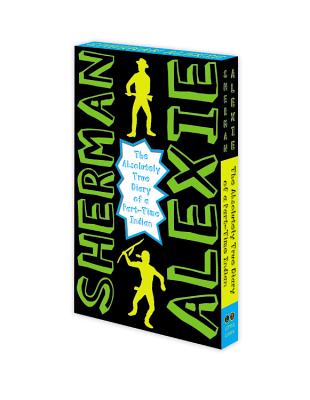to tease and bully hanseln, tyrannisieren
- Home
- About AICL
- Contact
- Search
- Best Books
- Native Nonfiction
- Historical Fiction
- Subscribe
- "Not Recommended" books
- Who links to AICL?
- Are we "people of color"?
- Beta Readers
- Timeline: Foul Among the Good
- Photo Gallery: Native Writers & Illustrators
- Problematic Phrases
- Mexican American Studies
- Lecture/Workshop Fees
- Revised and Withdrawn
- Books that Reference Racist Classics
- The Red X on Book Covers
- Tips for Teachers: Developing Instructional Materials about American Indians
- Native? Or, not? A Resource List
- Resources: Boarding and Residential Schools
- Milestones: Indigenous Peoples in Children's Literature
- Banning of Native Voices/Books
- Debbie on Social Media
- 2024 American Indian Literature Award Medal Acceptance Speeches
- Native Removals in 2025 by US Government
Showing posts with label The Absolutely True Diary of a Part-Time Indian. Show all posts
Showing posts with label The Absolutely True Diary of a Part-Time Indian. Show all posts
Thursday, June 09, 2011
Australian cover for ABSOLUTELY TRUE DIARY OF A PART TIME INDIAN
Sunday, September 12, 2010
Sherman Alexie on THE SNOWY DAY
Editors Note on Feb 25, 2018: Please see my apology about promoting Alexie's work. --Debbie
Earlier this year, in "I come to school for this class," I wrote about a terrific project in Arizona through which students at Westwood High School in Mesa, Arizona read literature by American Indian writers. The project was developed by James Blasingame and Simon Ortiz at Arizona State University.
I was pleased to see more about the project in "The Answer Sheet" --- a blog in the Education section of the Washington Post. Blasingame was their guest blogger. His wide ranging "An unusual introduction to Native American YA lit" touches on the writing of Joseph Bruchac and Sherman Alexie.
In his post, Jim points to one of his articles published in the Winter 2008 volume of The ALAN Review. Titled "From Wellpinit to Reardan: Sherman Alexie's Journey to the National Book Award, the article includes a lot of extensive quotes from Alexie. Here's one:
Alexie won the National Book Award for The Absolutely True Diary of a Part-Time Indian. There's a lot in the book that I really like because I connect with the character, the setting, the experiences... It is real and brutally honest. In one sense, I find it a bit too real, and I wonder if it didn't need to be quite that way... I'm thinking of his character's use of "faggot." I hear kids back home at Nambe toss that word around and I look at the young boys and wonder how that feels to those who may be gay?
Anyway, I am glad to learn that Alexie identified with the little boy in The Snowy Day and that he shared that memory with Jim. At the start of each semester, I ask students to bring in a book they remember. Tomorrow, I'll let them know about Alexie and his memory of The Snowy Day.
~~~~
I have a vivid memory of when I was six years old and pulled The Snowy Day, by Ezra Jack Keats, off the shelf in the elementary school library. On the cover was a dark boy in a red coat out in the snow. I instantly figured he was Indian, he wasn't, but I thought he was. I connected to that main character almost instantly in a lot of ways.
Monday, December 31, 2007
Jan Brett and Sherman Alexie
Editors Note on Feb 25, 2018: Please see my apology about promoting Alexie's work. --Debbie
Update on Sep 30 2023: I (Debbie Reese) no longer recommend Bruchac's work. For details see Is Joseph Bruchac truly Abenaki?
Today is December 31, 2007. We’re ending one year and starting another. Looking over the NY Times list of best selling children’s books, I note two books that are on the lists. These two books capture all that is good, and all that is not good, about books by and about American Indians.
~~~~
Today is December 31, 2007. We’re ending one year and starting another. Looking over the NY Times list of best selling children’s books, I note two books that are on the lists. These two books capture all that is good, and all that is not good, about books by and about American Indians.
On the chapter books list is Sherman Alexie’s The Absolutely True Diary of a Part-Time Indian. It represents all-that-is-good. I recommend it, and I give it as gifts. It is astounding on so many levels.
Before I start this discussion, I want to state clearly that I do not believe Jan Brett (or anyone who likes her new book) is racist or misguided. Mis-informed, or maybe, mis-socialized, mis-educated…. That is the root of the problem.
Both books have been on the best selling list for 14 weeks. As of today The Three Snow Bears is ranked at #4; Absolutely True Diary is ranked at #5.
The accompanying NYT blurb for The Three Snow Bears:
"Aloo-ki and the Three Bears: the Goldilocks tale goes to theArctic Circle ."
The blurb for Absolutely True Diary:
"A boy leaves his reservation for an all-white school."
The accompanying NYT blurb for The Three Snow Bears:
"Aloo-ki and the Three Bears: the Goldilocks tale goes to the
The blurb for Absolutely True Diary:
"A boy leaves his reservation for an all-white school."
Jan Brett is not an indigenous person. But like many writers, she has written (and illustrated) a book in which Native imagery figures prominently. A lot of writers retell Native stories, changing values and characters in such a way that the story can no longer be called Native. Pollock disneyfied The Turkey Girl, a story told among the Zuni people. Brett didn’t try to retell a Native story. She told an old favorite classic, and set her story in the Arctic . Her Goldilocks is an Inuit girl she named Aloo-ki.
The book flap for the hardcover copy says that Brett went to the Nunavut Territory in northern Canada , I gather, to climb to the Arctic Circle marker. While there she visited a school and according to the flap (note: authors don’t generally write the material on book flaps), “Jan saw the many intelligent, proud faces that became her inspiration for Aloo-ki.”
Why is “faces” modified with “intelligent” and “proud”? Is it Inuit faces that need these modifiers? Do you see such modifiers about the faces of any-kids in any-school? (I also want to say at this point that Brett's inspiration reminded me of Rinaldi's inspiration when she saw the names of Native kids on gravestones at Carlisle Indian School. Rinaldi was so moved by their names that she used the names, creating characters to go with them.)
The flap also says that she visited a museum where she “marveled at images of Arctic animals in Inuit clothes and felt a door had opened.”
My colleague, Theresa Seidel, addresses problems with the story (and the flaps) in her open letter to Jan Brett. She points out that in The Three Snow Bears, we have another book in which an author/illustrator puts Native clothing on animals, effectively de-humanizing American Indians.
Yes---Beatrix Potter did that in her Peter Rabbit stories, and nobody is making a fuss over that, but there is a difference.
The humanity of the people Potter’s bunnies represent is not questioned. Those people are recognized as people. Regular people. Not people (like indigenous peoples of the US and Canada) who are adored and romanticized. And, they're not a people who most others think vanished. Some people might put Princess Di on a pedestal and swoon over who she was, and they might swoon over some part of English culture, but they don’t do that to all of the English people.
In contrast, far too many people think we (American Indians, Inuits, First Nations) no longer exist. We (or rather, some semblance of who we were/are) do, however, make frequent appearances in fiction, as mascots on sports fields, as inspiration for troops whose helicopters and battleships and missile’s named after Native tribes, and on products from tobacco to automobiles to foodstuffs. For too many, we are an idea, not a living, breathing people whose kids go to the same schools as yours do.
Aloo-ki is surprised to come upon “the biggest igloo she had ever seen.” That’s worth a challenge, because it suggests that Aloo-ki is accustomed to seeing smaller igloos. Problem is, most people think that igloos are cute dwellings, about the size of dog houses. They’re actually quite large. If you saw the film, Atanarjuat (Fast Runner), you saw just how big igloos are. (Go to the movie’s website and view the galleries http://www.atanarjuat.com/galleries/movie.php).
In sum, Brett’s book is pretty to look at, a trinket, a decoration, but Native peoples are not trinkets or decorations.
We can agree that children who read picture books have different needs than those who read chapter books. But it IS possible to write picture books about present day Native kids. Native authors who’ve written precisely this kind of book are Joseph Bruchac, Joy Harjo, and Cynthia Leitich Smith.
Today, Diane Chen (a blogger at School Libray Journal) wrote about the need for discussion and growth, so that the children’s book world (and American society) can move beyond the place we are STILL at, where problematic books about American Indians are written, published, favorably reviewed, bought, and read by kids across the country.
We can do better, but the Jan Brett’s and their editors, their publishers, and reviewers, teachers, librarians, parents, booksellers, all have to listen to our concerns. This is not, from my point of view, an issue of racism. It is an issue of not-knowing, and being unwilling to admit errors.
With a new year upon us, can we give it a try?
.
Subscribe to:
Comments (Atom)













